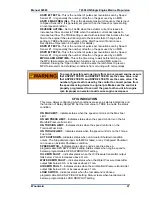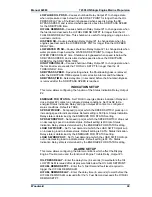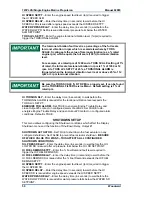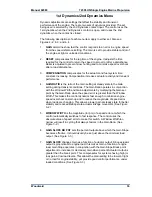
Manual 02880
723PLUS/Single Engine Marine Propulsion
Woodward
59
AMP LMT INPUT A (ENGR)
This sets the first break point of the AMPLC. It
should be adjusted to the air manifold pressure which represents the first break
point. The limit on fuel demand below this point is extrapolated from this point
and the AMP LMT INPUT B (ENGR) below.
FUEL LIMIT @ A (%FD)
This sets the maximum fuel demand at the first break
point. It may be set less than the start fuel limit and still allow the start fuel limit to
function.
AMP LMT INPUT B (ENGR)
This sets the second break point of the AMPLC. It
should be adjusted to the air manifold pressure which represents the second
break point.
FUEL LIMIT @ B (%FD)
This sets the maximum fuel demand at the second
break point.
AMP LMT INPUT C (ENGR)
This sets the third break point of the AMPLC. It
should be adjusted to the air manifold pressure which represents the third break
point.
FUEL LIMIT @ C (%FD)
This sets the maximum fuel demand at the third break
point.
AMP LMT INPUT D (ENGR)
This sets the fourth break point of the AMPLC. It
should be adjusted to the air manifold pressure which represents the fourth break
point
FUEL LIMIT @ D (%FD)
This sets the maximum fuel demand at the fourth
break point.
AMP LMT INPUT E (ENGR)
This sets the fifth break point of the AMPLC. It
should be adjusted to the air manifold pressure which represents the fifth break
point.
FUEL LIMIT @ E (%FD)
This sets the maximum fuel demand at the fifth break
point.
TORSIONAL FILTER
Torsional filter adjustments are the settings that affect the control’s ability to react
to flexible coupling torsionals. See Initial Adjustments in Chapter 4 for a more
detailed description of the adjustments for the Torsional Filter. A Notch Filter is
also provided with this control as an alternate filtering means for single speed
sensor applications requiring torsional filtering.
To use the notch filter, make sure that the speed sensor(s) used are
only on the engine side of the flexible coupling. Otherwise, an
overspeed with the possibility of serious injury or death is possible.
The notch filter is a bandstop filter. It rejects specific frequencies and allows all
others to pass. The idea is to reject the torsional (frequency on a frequency)
frequencies that the coupling produces, so that the actuator will not respond to
speed sensor changes it cannot control with the fuel. Systems with low frequency
oscillatory modes due to engine and driven load inertias and flexible couplings
are difficult to control. In the notch filter approach, no attempt is made to map the
oscillatory modes, but an effort is made to reduce the signal transmission through
the controller by a filter that drastically reduces the signal gain at the resonant
frequency.
There are two adjustments—NOTCH FREQUENCY and NOTCH Q FACTOR.
NOTCH FREQUENCY
is the center frequency of rejection, and the units are
defined in hertz. In tuning the notch filter, the resonant frequency must be
identified and entered. The allowed frequency range of the notch filter is 0.5 to
16.0 Hz.
Summary of Contents for 723PLUS
Page 8: ...723PLUS Single Engine Marine Propulsion Manual 02880 vi Woodward ...
Page 15: ...Manual 02880 723PLUS Single Engine Marine Propulsion Woodward 7 ...
Page 17: ...Manual 02880 723PLUS Single Engine Marine Propulsion Woodward 9 ...
Page 116: ...723PLUS Single Engine Marine Propulsion Manual 02880 108 Woodward ...
















































